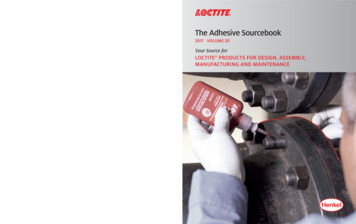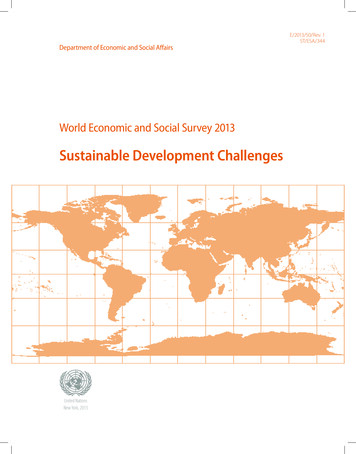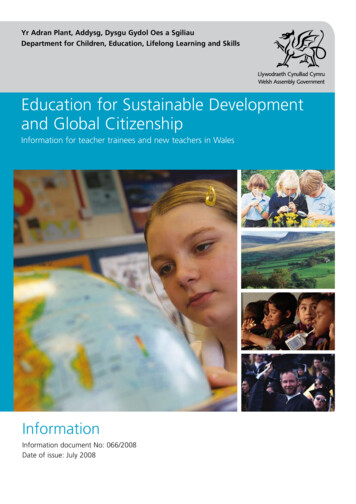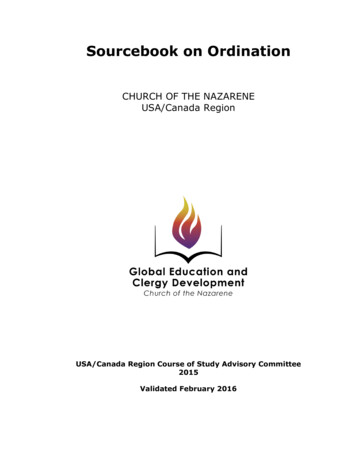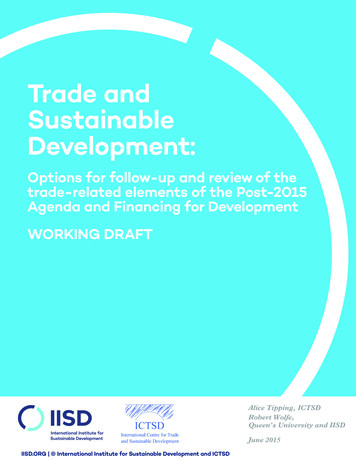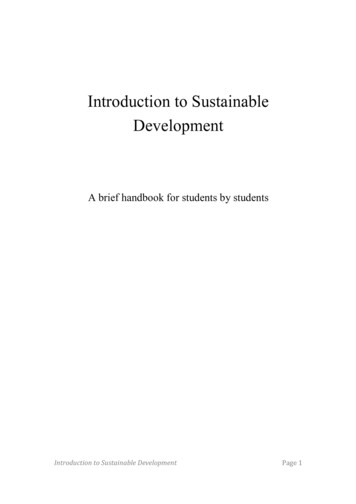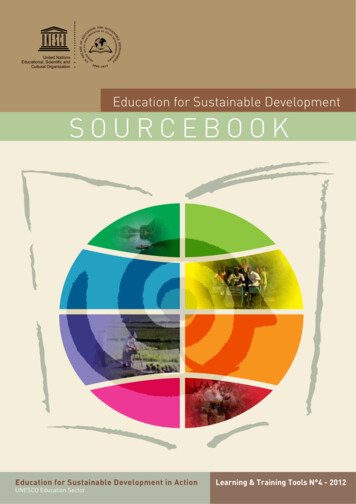
Transcription
United NationsEducational, Scientific andCultural OrganizationEducation for Sustainable DevelopmentSOURCEBOOKEducation for Sustainable Development in ActionUNESCO Education SectorLearning & Training Tools N 4 - 2012
Education for Sustainable DevelopmentSOURCEBOOKPublished in 2012 by the United Nations Educational,Scientific and Cultural Organization7, place de Fontenoy, 75352 Paris 07 SP, France UNESCO 2012All rights reservedISBN 978-92-3-001063-8The designations employed and the presentation of material throughout thispublication do not imply the expression of any opinion whatsoever on thepart of UNESCO concerning the legal status of any country, territory, city orarea or of its authorities, or concerning the delimitation of its frontiers orboundaries.The ideas and opinions expressed in this publication are those of theauthors; they are not necessarily those of UNESCO and do not commit theOrganization.Cover photos: 2004/P-Werquin - Agriculture 2004/P-Werquin - Pêcheuses Vietnam 2011/P-Werquin - Femmes Africaines Vasant Davé/Grandpa’s picnic 2Graphic design: Helmut LangerLayout: UNESCOwith support fromUnited Nations Cultural OrganizationJapanFunds-in-Trust
Table of ContentsAbout this publication .ÎBriefs for Primary and Secondary Teachers .ÎWhat is Sustainable Development? .ÎReorienting Curriculum to Address Sustainability .ÎTeaching Techniques for ESD .ÎESD Lesson Plans .ÎAssessing Pupil Learning with Rubrics .ÎExtra-Curricular Activities .ÎBriefs for Decision-Makers .ÎWhat is ESD? .ÎESD and Adjectival Educations .ÎThe Strengths Model .ÎCurricular Analysis: Finding sustainability in existing curricula .ÎWhole-School Approach to Sustainability .ÎESD Resources from UNESCO .Î
About this PublicationThe target audiences for the Education for SustainableDevelopment Sourcebook are primary and secondary teachersand mid-level decision-makers, who have responsibility forprimary and secondary education. Another primary audienceis teacher educators who work with pre-service and in-serviceprimary and secondary school teachers.The purpose of the publication is to describe ways inwhich education for sustainable development (ESD) canbe integrated into primary and secondary schooling. Thiscollection of briefs is designed to complement other ESDmaterials published by UNESCO. The topics for the briefswere selected in consultation with UNESCO Field Offices andInstitutes. The briefs for primary and secondary teachers arespecifically written for professional educators who work informal education settings. The briefs for teachers as well asthose for decision-makers address “gaps” in the UNESCO ESDliterature.www.unesco.org/en/esd/videos/2
ESD SourcebookFor teachersUnited NationsEducational, Scientific andCultural OrganizationWhat is Sustainable Development?“We hold the future in our hands. Together, we must ensure that our grandchildren will not have to ask why we failedto do the right thing, and let them suffer the consequences.”UN Secretary-General Ban Ki-moon, 2007Sustainable development is the overarching paradigm of theUnited Nations. The concept of sustainable developmentwas described by the 1987 Bruntland Commission Report as“development that meets the needs of the present withoutcompromising the ability of future generations to meet theirown needs.”Sustainability is a paradigm for thinking about a future inwhich environmental, social and economic considerationsare balanced in the pursuit of development and an improvedquality of life. These three spheres – society, environmentand economy – are intertwined. For example, a prosperoussociety relies on a healthy environment to provide food andresources, safe drinking water, and clean air for its citizens.The sustainability paradigm is a major change from theprevious paradigm of economic development with itsdamaging social and environmental consequences. Untilrecently these consequences have been seen as inevitableand acceptable. However, we now realize that major damageor serious threats to the well-being of humans and theenvironment in pursuit of economic development have noplace within the sustainability paradigm.EnvironmentEnvironmentthought of as a long-term goal (i.e. a more sustainable world),while sustainable development refers to the many processesand pathways to achieve it (e.g. sustainable agriculture andforestry, sustainable production and consumption, goodgovernment, research and technology transfer, education andtraining, etc.).Principles of Sustainable DevelopmentAll sustainable development programmes must consider thethree spheres of sustainability – environment, society andeconomy – as well as an underlying dimension of culture.Since sustainable development addresses the local contexts ofthese three spheres, it will take many forms around the world.The ideals and principles that underlie sustainability includebroad concepts such as equity among generations, genderequity, peace, tolerance, poverty reduction, environmentalpreservation and restoration, natural resource conservation,and social justice. The Rio Declaration1 contains 27 principles,including:t People are entitled to a healthy and productive life inharmony with nature;t The right to development must be fulfilled so as to meetdevelopmental and environmental needs of present andfuture generations in an equitable way;SocietySocietyEconomyt Eradicating poverty and reducing disparities in livingstandards in different parts of the world are essential tosustainable development.Economyt Environmental protection is an integral part of thedevelopment process and cannot be considered inisolation from it.VISUALIZING SUSTAINABILITYWe might then ask, what is the difference between sustainabledevelopment and sustainability? Sustainability is often1The Rio Declaration emerged from the United Nations Conferenceon Environment and Development, also called the Earth Summit, which washeld in Rio de Janeiro in 1992. A total of 172 governments participated,including 108 heads of state or government. Agenda 21 is the officialdocument of the Earth Summit.2
What is Sustainable Development?t International actions in the fields of environment anddevelopment should also address the interests and needsof all countries.t To achieve sustainable development and a higher qualityof life for all people, countries should reduce and eliminateunsustainable patterns of production and consumptionand promote appropriate demographic policies.t Seeing all humans as having universal attributes.t Knowing that technology and science alone cannot solveall of our problems.t Emphasizing the role of public participation in communityand governmental decision-making. People whose liveswill be affected by decisions must be involved in theprocess leading to the decisions.t Women play a vital role in environmental managementand development. Their full participation is thereforeessential to achieving sustainable development.t Calling for greater transparency and accountability ingovernmental decision-making.t Warfare is inherently destructive to sustainabledevelopment. Peace, development and environmentalprotection are interdependent and indivisible.t Employing the precautionary principle – taking actionto avoid the possibility of serious or irreversibleenvironmental or social harm even when scientificknowledge is incomplete or inconclusive.These principles can guide the efforts of governments,communities and organizations to define sustainability goalsand create programmes to help achieve those goals.It is important that educators, leaders, and citizens recognizethat sustainable development is an evolving concept andthat the list of sustainability perspectives can therefore growand change.Perspectives of Sustainable DevelopmentNot all the concepts associated with sustainability areincorporated in the 27 principles of sustainable developmentin the Rio Declaration. Accompanying principles of sustainabledevelopment are perspectives that have become part of theglobal sustainability dialogue, such as:t A systems thinking approach2 , rather than an approachthat looks at problems in isolation should be used.Sustainability issues are linked and part of a “whole.”t Understanding local issues in a global context andrecognizing that solutions to local problems can haveglobal consequences.t Realizing that individual consumer decisions affect andgive rise to resource extraction and manufacturing indistant places.t Considering differing views before reaching a decision orjudgement.t Recognizing that economic values, religious values, andsocietal values compete for importance as people withdifferent interests and backgrounds interact.2Systems thinking is the process of understanding how elementsof a system influence one another within the whole. Systems thinking, alsocalled a whole-systems approach has been defined as an approach to problemsolving, in which “problems” are viewed as parts of an overall system, ratherthan as isolated parts, outcomes or events.Values within the Sustainability ParadigmThroughout its history, the United Nations has been achampion of values related to human dignity, fundamentalfreedoms, human rights, equity, and care for the environment.Sustainable development takes these values a step further,extending them beyond the present generation to futuregenerations. Sustainable development means valuingbiodiversity and conservation along with human diversity,inclusivity, and participation. In the economic realm, someembrace sufficiency for all while others uphold equityof economic opportunity. Another vehicle for the valuesinherent in the sustainability paradigm is the Earth Charter,a declaration of fundamental ethical principles for building afair, sustainable, and peaceful global society.Sustainable Development TopicsSustainable development includes a number of topics,which U.N. Member States have agreed to address. Withtheir environmental, social, economic and political roots,these topics are complex and are often difficult to defineas well as find solutions for. They include reducing poverty,changing consumption patterns, global population growth,and protecting human health, all of which present challengesto our social and economic systems. In addition, the topicsalso include protecting the land we live on, the water we2
What is Sustainable Development?drink, the air we breathe, and the resources we use as well asmajor contemporary challenges like climate change and lossof biodiversity. The list is extensive. All of these and relatedtopics can be approached from a sustainability perspective.ReferencesEarth Charter. 2000. Read-the-Charter.htmlICLEI. Local Governments for Sustainability.http://www.iclei.org/ (Accessed 22 June 2011.)Creating Sustainability Goals and PlansFollowing the Earth Summit in 1992, governments andcommunities were charged with the responsibility of creatingsustainability plans. In order to do so, governments andcivil society must identify priorities and create sustainabilitygoals. Then, they can create plans to achieve them. Ideally,at the national level, every ministry or department wouldinclude sustainability in its goals, plans and policies giventhat it is the responsibility of all sectors of governments andsocieties to work towards a more sustainable future.Coordinated EffortsGovernments and civil society as well as individuals musthold the responsibility for a more sustainable future. All mustcontribute in their own way. The 40 chapters of Agenda 21describe ways forward in many areas, from agriculture towaste disposal. Nevertheless, the education community hasa special role to perform. Explicitly mentioned in each ofthe chapters, education is an essential ingredient for a moresustainable future. For example, it is through education thatthe next generation of citizens, voters, workers, professionalsand leaders are prepared for life-long learning. Withouteducation, progress towards a more sustainable future willbe compromised. Indeed, we must learn our way forward.UNESCO. 2006. Education for Sustainable DevelopmentToolkit. Learning & Training Tools No1. 3eo.pdfAlso available online in html at http://www.esdtoolkit.orgRio Declaration. fault.asp?documentid 78&articleid 1163United Nations Department of Economic and Social Affairs.2009. Division on Sustainable Development. SustainableDevelopment Topics http://www.un.org/esa/dsd/susdevtopics/sdt index.shtmlUNESCO. 2005. UNESCO & Sustainable Development. 13/001393/139369f.pdf (French)2
ESD SourcebookFor teachersUnited NationsEducational, Scientific andCultural OrganizationReorienting Curriculum to Address SustainabilityReorienting a curriculum to address sustainability can takeplace at a classroom or national level.At the classroom level, teachers can begin by explicitlystating the link between the topic in the mandated syllabusand sustainability. For example:t Today we are learning about World War II. As you know,war is considered an unsustainable state in which humanlives are lost and resources wasted. One of the principlesof sustainability is that warfare is inherently destructive tosustainable development. Why do you think war preventscountries from making progress towards sustainability?(e.g. rather than spending national income on humanwell-being it is spent on human destruction).The reorienting process can also occur at national levels orprovincial/state levels in ministries of education where themandated curriculums are written. A national or provincialprocess should be conducted more systematically andthoroughly than a reorienting process carried out by a teacherworking in isolation or by a small team of teachers workingin a school. A national or state level process would includeinviting stakeholders to a public participation process togather input (e.g. statements of needs and desires as wellas opinions) related to the reorienting process. In thisway, a ministry will be modelling public participation andtransparency, which are essential elements of sustainability.(See Case Study: Toronto Board of Education CurriculumRevision and Reorientation, http://www.esdtoolkit.org/discussion/case study.htm).t Today we are discussing health risks related tocontaminated water. Access to water is now considereda human right, and human rights are fundamental increating sustainable communities.To reorient a curriculum to address sustainability,educational communities need to identify theknowledge, issues, perspectives, skills, and valuescentral to sustainable development in each of thethree components of sustainability – environment,society, and economy – and integrate them into thecurriculum. The education community also needsto decide which of the many existing sustainabilityissues (e.g. biodiversity, climate change, equity, andpoverty) will be part of the curriculum. Ideally, effortsto reorient education will be based on national or localsustainability goals. A properly reoriented curriculumwill address local environmental, social, and economiccontexts to ensure that it is locally relevant andculturally appropriate.t Today we are talking about international trade. Thinkabout the shirt that you are wearing and where the fibrecame from, where the cloth was made, where the shirt wassewn, and how it was transported to where you are. Howmuch energy did that take? What is the carbon footprintof your shirt? How is your shirt related to sustainable useof resources?From simple statements such as these, pupils will build theirconceptions of sustainability and their knowledge of it.Several tools to reorient a curriculum to address sustainabilityhave been created. The ESD Lens “Review Tool 9: ESDintegration in the curriculum” provides a way for analysingthe extent to which ESD is integrated in the curriculum atnational and school levels. The Education for SustainableDevelopment Toolkit contains eight exercises for reorienting acurriculum to address sustainability and holding communityforums to gather public opinion related to curricularchange. “Project Y” has also been used widely to integratesustainability into existing lesson plans and units. Project Ytakes a gradual approach, introducing one or a few new itemsrelated to sustainability in each lesson. Over the course ofa school year, the aggregate amount of sustainability taughtand time on task (i.e. learning about sustainability) can besubstantial.In an effort to save time or resources, governments haveimported curricula from other countries or regions. Inthe case of ESD, this is inappropriate, because localand national sustainability goals and local contextswill not be well targeted.See Sample Activities:2ESD Lens Review Tool 9: ESD integration in the curriculumProject Y: Exercises of reorienting curriculum
Reorienting Curriculum to Address SustainabilityTo access the ESD Lens Review Tool 9: ESD integration inthe curriculum, open the following hyperlink and go to page68. Review Tool 9 focuses on the extent to which ESD isintegrated into the 01908/190898e.pdfReferencesUNESCO. 2006. Education for Sustainable DevelopmentToolkit. Learning & Training Tools No. 1. 3eo.pdf. Alsoavailable online in html at http://www.esdtoolkit.orgTownsville State High School Sustainability program. no sf.html(Accessed 2 July 2010.)UNESCO. 2010. ESD Lens Review Tool 9 ESD integration inthe curriculum. ESD Lens: A Policy and Practice Review tool.Learning & Training Tools, No. 898e.pdf2
Project Y: Exercise for reorientingcurriculumDirections: Identify a lesson plan or unit that you currently teach. Write the name of the unit in the circle. Categorize whatyou currently teach using the chart below. How can you add one or more sustainability elements related to knowledge, issues,skills, perspective or values to this lesson or unit?SocietyEconomyKnowledgeKnowledgeAlready in my unit:I would like to add:Already in my unit:I would like to add:Local IssuesLocal IssuesAlready in my unit:I would like to add:Already in my unit:I would like to add:SkillsSkillsAlready in my unit:I would like to add:Already in my unit:I would like to add:PerspectivesPerspectivesAlready in my unit:I would like to add:Already in my unit:I would like to add:ValuesValuesAlready in my unit:I would like to add:Already in my unit:I would like to add:EnvironmentKnowledgeLocal IssuesSkillsPerspectivesValuesAlready in my unit:I would like to add:Already in my unit:I would like to add:Already in my unit:I would like to add:Already in my unit:I would like to add:Already in my unit:I would like to add:2
Reference Sheet for Completing Project YWorksheetReorienting education involves selecting appropriate knowledge, issues, skills, perspectives, and values for theenvironmental, social, and economic spheres of sustainability. The following are suggestions to begin completing aPROJECT Y worksheet.KnowledgePeople need basic knowledge from the natural sciences, social sciences, and humanities to understand:t the principles of sustainable development,t how they can be implemented,t the values involved, andt the ramifications of their implementation.SkillsESD must provide people with the practical skills that will enable them to:t continue learning after they leave school,t to find a sustainable livelihood, andt to live sustainable lives.Examples:i The ability to communicate effectively both orally and in writing;i The ability to think about systems (both natural and social sciences);i The ability to think in terms of time – to forecast, to think ahead, and to plan;i The ability to think critically;i The ability to use multiple perspectives to understand another person’s viewpoint;i The ability to analyse values underlying differing positions;i The capacity to move from awareness to knowledge to action;i The ability to work cooperatively with other people;i The capacity to develop an aesthetic response to the environment and the arts.2
Reference Sheet for Completing Project YWorksheetIssuesEvery community has sustainability issues. Reorienting education includes selecting issues that are relevant to the localcommunity. Here are a few of many possible issues:AgricultureHuman settlementAtmosphereIndigenous peopleBiodiversityLand useChanging consumption patternsOceansClimate ChangePopulation growthDeforestationPovertyDesertification and droughtProtecting and promoting human healthFresh waterSolid and hazardous wastes and sewageGender equityPerspectivesPerspectives on sustainability are commonly statements that expand upon the principles of sustainable development found inAgenda 21. Principles include, but are not limited to:t Environmental protection and human-centred development are considered together, not separately.t There must be a balance and integration of environment, society, and economy.t States have a right to development, but must respect geographic boundaries.t Partnerships can achieve more than solitary action.t Social and environmental problems change through time and have both a history and a future.t Contemporary global environmental issues are linked and interrelated.t Systems thinking or a whole-systems approach should be used in problem solving rather than looking at problems inisolation.t Humans have universal attributes.t The family is the foundational social unit.t Local issues must be understood in a global context and we should realize that solutions to local problems can have globalconsequences.t Individual consumer decisions and other actions affect and give rise to resource extraction and manufacturing in distantplaces.t Differing views should be considered before reaching a decision or judgement.t Economic values, religious values, and societal values compete for importance as people with different interests andbackgrounds interact.2
Reference Sheet for Completing Project YWorksheett Technology and science alone cannot solve all of our problems.t Individuals are global citizens in addition to being citizens of the local community.t Communities are built for all people regardless of income, ethnicity, status, etc.t Community and governmental decision-making must include public participation. People whose lives will be affected bydecisions must be involved in the process leading to the decisions.t Transparency and accountability in governmental decision-making are essential.t The decentralization of governmental decision-making allows people to find solutions that fit local environmental, social,and economic contexts.t Employing the precautionary principle – taking action to avoid the possibility of serious or irreversible environmental orsocial harm, especially when scientific knowledge is incomplete or inconclusive – is necessary for the long-term well-beingof a community and our planet.ValuesUnderstanding values (e.g. one’s own values, the values of the society one lives in, and the values of others around the world)is an essential part of understanding one’s own and other people’s viewpoints. Values from the Earth Charter include:t Respect the Earth and life in all its diversity.t Care for the community of life with understanding, compassion, and love.t Build democratic societies that are just, participatory, sustainable, and peaceful.t Secure the Earth’s bounty and beauty for present and future generations.t Eradicate poverty as an ethical, social, and environmental imperative.t Affirm gender equality and equity.t Uphold the right of all, without discrimination.t Treat all living beings with respect and consideration.t Promote a culture of tolerance, nonviolence, and peace.Principles of Sustainable DevelopmentThe Rio Declaration contains 28 principles of sustainable development including:t People are entitled to a healthy and productive life in harmony with nature;t Eradicating poverty and reducing disparities in living standards is essential;t Warfare is inherently destructive to sustainable development.2
Reference Sheet for Completing Project YWorksheetHerman Daly’s three conditions of a sustainable society:(1) Rates of use of renewable resources do not exceed their rates of regeneration.(2) Rates of use of non-renewable resources do not exceed the rate at which sustainable renewable substitutes are developed.(3) Rates of pollution emission do not exceed the assimilative capacity of the environment.Donnella Meadows outlined these general guidelines for restructuring world systems towards sustainability:(1) Minimize the use of non-renewable resources.(2) Prevent erosion of renewable resources.(3) Use all resources with maximum efficiency.(4) Slow and eventually stop the exponential growth of population and physical capital.(5) Monitor the condition of resources, the natural environment, and the welfare of humans.(6) Improve response time for environmental stress.ReferencesDaly, H.E. & Cobb J.B. 1989. For the Common Good. Boston: Beacon Press Books. Chelsea Green Publishing Company.Earth Charter. no ages/Read-the-Charter.html(Accessed 2 July 2010.)UNESCO. 2006. Education for Sustainable Development Toolkit. Learning & Training Tools No. 1. 3eo.pdfAlso available online in html at http://www.esdtoolkit.orgMeadows, D.H., Meadows, D.L. & Randers, J. 1992. Beyond the Limits: Confronting Global collapse, Envisioning a SustainableFuture. White River Junction: Vermont.2
ESD SourcebookFor teachersUnited NationsEducational, Scientific andCultural OrganizationTeaching Techniques for ESDQuality EducationUNESCO has identified ten key aspects that support qualityeducation related to the individual learner and to systemsof education. Five of these aspects are at the level of thelearner, including:t seeking out the learner,Another form of equity inherent in sustainability that isvisible in the classroom is related to gender. Consideringthat men and women, particularly in rural and indigenoussocieties, tend to have quite different socio-cultural roles,classroom teaching techniques need to be employed inlocally relevant and culturally appropriate ways that fostergender equity. The same is true for access to educationalresources for both boys and girls.t acknowledging the learner’s knowledge and experience,ESD Pedagogiest making content relevant,t using many teaching and learning processes, andt enhancing the learning environment (UNESCO, 2005).By using a variety of teaching techniques, teachers helppupils employ and develop different learning processes. Withvariety, pupils have a chance to grow as learners and toenhance their skills and capacity to learn and think.A quality education implies that the needs of individuallearners will be considered and addressed in developing anddelivering lessons. By using a variety of teaching techniques,the teacher attends to the diverse needs of the pupils in theclass. Not all students learn in the same way. Some prefer tolisten, others to read, and still others to participate moreactively. Unfortunately, traditional pedagogies mainly servepupils who are good at listening, reading, memorizing andsitting still; however, not all pupils have these abilities. Yeteducation is for all.Meeting the learning needs of all pupils in the classroom is aform of social equity, which is a core concept of sustainability.For many years, the educational community did not linkteaching techniques with social equity. Previously, only thepupils who were good at reading, memorizing and recitingexcelled in school. Those pupils who were not did not thrivein school and often dropped out, thereby limiting theircareers and economic potential. Dropping out of school isa major social and economic sustainability issue. However,using a variety of teaching techniques to meet the learningneeds of pupils can address equity in the classroom. Suchpractice also demonstrates to the pupils a form that equityand social sustainability can take. Pedagogies used inschool, like other educational practices (e.g. a whole-schoolapproach to sustainability), can therefore promote principlesof sustainability.Pedagogies associated with ESD stimulate pupils to askquestions, analyse, think critically and make decisions.Such pedagogies move from teacher-centred to studentcentred lessons and from rote memorization to participatorylearning.ESD pedagogies are often place-based or problem/issuebased. ESD pedagogies encourage critical thinking, socialcritique, and analyses of local contexts. They involvediscussio
society relies on a healthy environment to provide food and resources, safe drinking water, and clean air for its citizens. The sustainability paradigm is a major change from the previous paradigm of economic development with its damaging social and environmental consequences. Until recently these consequences have been seen as inevitable

